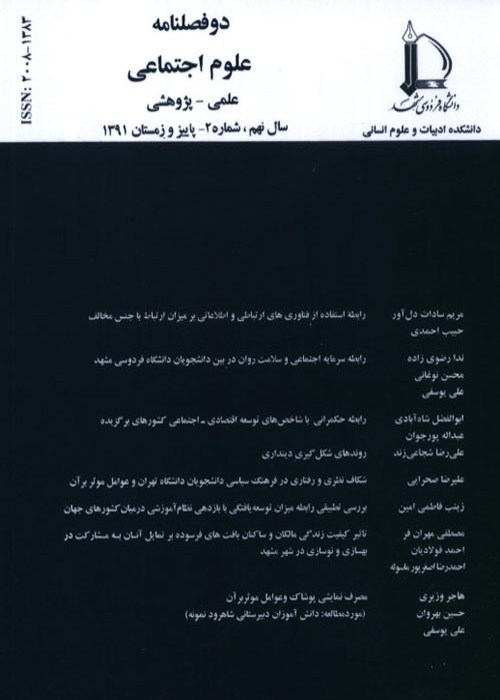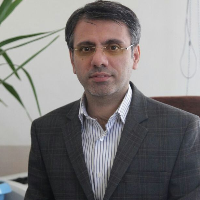Social Tolerance in Mulitcultural Societies: A Survey of the Miyandoab Citizens
Dominant approaches in the Iranian civilization have always been accompanied by cultural tolerance and compromise. The case studied in this inquiry (Miandoab City) is a collection of cultural diversity due to its high level of immigration to the city as well as being located among three provinces. In the multiethnic and multicultural area where life went on peacefully until the past decade, there has often been a number of controversies between communities that resulted in military intervention. It has brought about signs of uncertainty and vulnerability with regards to social tolerance between various identities. Accordingly, the main research question in this study is: to what extent the people who belong to different religious cults tolerate others in this multiethnic, multicultural texture? What are the effective factors on the social tolerance of Miandoab citizens?
A thorough review of the conducted studies regarding social tolerance illustrates that most of the studies carried out in Iran have focused on the political aspect of tolerance, using samples of University students (Serajzadeh et al., 2004; Share’pour & Khoshfar, 2002; Golabi & Rezaei, 2013; Shahryari et al., 2015) and citizens (Moghtadaei, 2010; Adibisadeh et al.,2014;Jalaeian Bakhshandeh & et al., 2018) social and civil aspects of tolerance should be addressed among ethnic and religious communities. Due to its multicultural nature, the City of Miandoab in West Azerbaijan Province is a good field to deconstruct tolerance among ethnic groups of Kurds and Turks and religions of Shiite and Sunni.Considering the multicultural nature of the society of Iran, the accomplished researches about tolerance, social distance, and cross-cultural sensitivities among ethnic communities are scarce and partial. Theoretical and experimental literature of tolerance has a sixty-year-old history (Mather & Tranby, 2014).In the modern society, tolerance is recognized as a civil, political virtue. Considering the theoretical approach of King (1975), Daren and Tranby (2014) and exemplar restriction of Elisabetta (2002), the notion of tolerance has been conceptualized within political, religious, identity, and behavioral dimensions.According to theoretical and experimental studies by Mather and Tranby (2014), Golebiowska (1999), and Parillo and Donoghue (2005), social tolerance is influenced by contextual factors such as gender, religion, and ethnicity. These contextual factors contain macro structure conditions. According to Bourdieu (1986), the distributer of the whole capital (as a consequence of economic and cultural capitals) and capital structure (relative weight of economic and cultural capitals) within the social field determine the social position of actors, who are then considered to be at the same level as those similar to them in terms of the whole capital (Bourdieu, 1984). Putnam also asserted the role of social, economic, and cultural capitals in development and improvement of social tolerance (Putnam, 2001). Various forms of capitals are effective in mediating and expanding individuals’ insights and mental horizons, enhancing relativism and relative thinking, and shifting from exclusive to multiple identities. In fact, the rejection of multiplicity and refusing selection in identity related subjects can bring about a considerably unilateral and punitive perspective (Sen, 2016). Considering the exclusive nature of religious and ethnic identities along with the multicultural texture of the case (with Kurd and Turk ethnicities and faiths including Sunnis and Shiites), ethnic and religious orientations affect social tolerance. Accordingly, Miandoab citizens’ reconsideration of exclusive identities depends on the extent to which they enjoy social capitals and the range of their interactive field.
In this study, cross-sectional survey method was used with two purposes including description and explanation. Questionnaires were used for data collection. The total population of the study included individuals between the ages of 18-50 living in Miandoab; the sample population was obtained as 313 individuals based on the Cochran’s formula. As the present study was focused on exploring social tolerance mediated by various forms of capitals, “multistage cluster” probability sampling was employed. In the case studied in this inquiry, Sunnis and Kurds mostly live in underprivileged and semi-privileged areas; given the sensitivity of the subject, only the literate and employed individuals consented to cooperate with the research. The validity of the questionnaire was improved through formal validity and confirmatory factor analysis.
Findings showed that the average social tolerance is higher among Kurds and Sunnis compared to Turks and Shiites. Furthermore, the average economic, social and cultural capitals and ethnic orientations were higher among Turks and Shiites relative to Kurds and Sunnis. The average religious orientation were higher in Kurds and Shiites than Turks and Sunnis. According to the results obtained from bivariate analyses, there is a positive, significant relation between social tolerance and various forms of capitals. Meanwhile, the most considerable influence is related to the cultural and economic capital variable. In addition, there is an inverse relation between religious and ethnic orientations and social tolerance. Among contextual variables, there is a positive, significant relation between education and social tolerance while there is an inverse, insignificant relation between the variable of age and social tolerance. Based on the results of regression analysis, independent variables explain 52.3% of changes in social tolerance.The descriptive results showed that social tolerance of Miandoab citizens is at an average level. The results showed a positive, significant relation between enjoying various forms of capitals and social tolerance. In terms of ethnicity, the settlement of the majority of Kurds at marginal rural areas denote economic inequalities and undoubtedly, the absence of effective communicational exchange. Moreover, the results also showed an inverse, negative relation between ethnic and religious orientations and social tolerance. In such a situation, the tolerance of religious people and those who follow an exclusive, closed capital and act according to social norms and values are at a lower level.
Political tolerance among the examined sample is at an average level which could be a preventive factor; subsequently, legitimate freedoms should be recognized in terms of ethnicity and religion for improvement, while the means for their realization should be pragmatically provided as well. The low percentage of identity tolerance in the form of cults and the four main religions (The Righteous, Baha’i, Sunnis, and Shiites) rejecting one another represent the lack of communication and unity between the members of social groups examined in this study. Through increasing social connections among religions, the orientation of the generally tolerant subject of Daren and Tranby (2014) would be easier to attain, subsequently resulting in the maximum level of tolerance. In the behavioral aspect of social tolerance, engagement and enhancement of direct group projects would functionally bring gender-related sensitivities to public areas. The role of education institutes in influencing and imparting gender differences is of importance.
- حق عضویت دریافتی صرف حمایت از نشریات عضو و نگهداری، تکمیل و توسعه مگیران میشود.
- پرداخت حق اشتراک و دانلود مقالات اجازه بازنشر آن در سایر رسانههای چاپی و دیجیتال را به کاربر نمیدهد.



